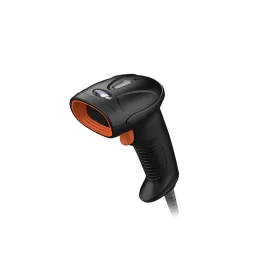RFID vs Barcode: Comparison, Advantages & Disadvantages
800-900 MHz and higher. UHF RFID is typically used in large warehouses and distribution centers that need to track and identify multiple items at once.
Systems that use UHF RFID are not as mature as those used by LF and HF RFID frequencies. A standardized global bandwidth has not yet been determined, and the frequency range varies by country. The U.S. currently uses a higher UHF bandwidth than Europe.
Common applications for UHF RFID include shipping and receiving, end-to-end manufacturing, and industrial asset management. Unlike LF or HF, UHF offers a much longer read range of up to 30 feet in the right conditions. UHF wavelengths also allow data to be transferred more quickly, which means large volumes of product can be moved faster.
When receiving pallets or large cases, UHF RFID technology can speed up the process. A designated dock door can be equipped with RFID readers that are tuned to the same bandwidth as the tags on the items being received. With proper implementation to minimize interference, it can provide an accurate, efficient way to move items through the supply chain.
In these examples, RFID has clear advantages over barcodes when it comes to durability and longevity, security and efficiency. But this technology has disadvantages, too, and there are situations where barcoding is far more practical.
Learn more about RFID trends and future applications.
Many warehouses can benefit from the full spectrum of bar code applications, but you should do the necessary detail cost benefit studies to determine your Return On Investment (ROI). Our recommendation is to begin with the basics and move to more advanced applications if you have the luxury and desire to use a phased in approach.
Further reading:Consumer Electronics
Do Barcode Scanners Use Infrared?
Outdoor Readability with LCD Optical Bonding: A Game-Changer for Devices
How Do I Choose an LED Video Wall?
Key Factors to Consider When Choosing an Industrial Touch Screen Monitor
60 vs. 72-cell Solar Panels: Which Size is Right for You?
How Are Barcode Scanners So Accurate?
The following are some of the benefits that can be gained with the use of bar code technology in the warehouse.
- Fast and accurate capture of data reduces paperwork and chance of errors. Your objective should be to eliminate manual clerical, time consuming tasks. The bar code data capture and positive confirmation of transactions will significantly reduce errors from keying from manual systems in receiving, put away, replenishment, picking, inventory control, etc.
- Reduced labor costs. Some savings will be realized from clerical hours by eliminating paperwork keying. Other savings will come from faster picking throughput, resulting in less headcount needed.
- Timely information. It should be noted that not all bar code systems or functions are necessarily real time, but rather near real time, utilizing batch updates every 15 minutes for example. Examples include product receiving reports, labor hours capture by function, cycle counting that may alert you to warehouse back orders, etc. But note you have to have information systems to support these functions.
- Productivity measurement. Accurate and timely data capture ability to track individual and department function performance and posting individual results will increase productivity.
- Reduced training time. Warehouse processes using bar coding are often easier to teach new employees because it streamlines and clearly defines processes and best practices and more importantly your company’s warehouse standard operating procedures. The implementation of bar coding requires standardization and disciple of processes which is a huge benefit.
- Better decision making. This culminates in the most accurate and timely data capture you can gain to better utilize your inventory and people assets. You will not be dependent on individual managers to collect data in their timeframes and with their methods. You can implement standardization processes of how warehouse department managers plan and control work.
Bar Code Technology Issues to Consider
Although there are many benefits attainable through bar code technology, there are a few key issues and concerns that should be recognized in making decisions as to how to utilize the technology. A few of these issues are as follows:
- Many warehouse operations are based on having individual selling units bar coded by the manufacturer. If they are not, they must be relabeled in the warehouse which can be a costly process. In order to have vendors or manufacturers apply bar code labels, some type of Vendor Compliance process is required. This can be a sizeable task to implement and maintain.
- The labeling of all locations with bar code labels can be a time consuming and expensive process. Don’t assume that this will happen easily or quickly.
- If your business consists of a few items and relatively few orders, the cost and effort to implement the technology may not be justified. Make sure the ROI is calculated and considered before jumping into any technology.
- The acquisition and implementation cost of equipment and backbone infrastructure can be significant.
- Generally, there is a requirement to have some type or level of Warehouse Management System in place to fully utilize the concept.
Bar code systems of themselves for example to not have labor management systems; whereas a warehouse management system with bar code may have a labor management module. - Remember the bar code technology requirements to utilize the advanced technologies (e.g. Pick to Light and Voice Picking). The evaluation of these requirements and costs should be completed before any final
decisions are made with these technologies. - Take into account the implementation tasks, training and culture shift these technologies may require in your operation. Several years ago we saw a large multichannel retailer assume they could take their first bar code inventory to initialize the inventory for their WMS implementation at the same time. The inventory process and re-ticketing was a disaster and therefore the warehouse management system implementation failed. Another example is if your center relies on “tribal knowledge” to know where products are located rather than bar code bin/slot locations, anticipate and train to overcome resistance and problems with picking, inventory, put away etc.
RFID vs Barcode: Comparison, Advantages & Disadvantages
Pros and Cons of Bar Code Technology
Suggested reading:How much do you tip for a guided tour?
How Much Should I Tip My Guide? We Asked Guides How ...
Should You Tip US Tour Guides? (Simple Formula)
What is better tower or all-in-one?
Best tablet 2023: the top tablets you can buy right now
What price tag solution should I choose for my business?
How Long Will a Power Bank Hold Its Charge?


